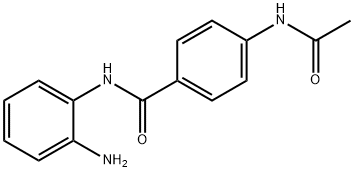CI-994 (112522-64-2) is an orally active histone deacetylase (HDAC) inhibitor, IC50 = 0.9, 0.9, 1.2 and >20 μM for HDAC1, HDAC2, HDAC3 and HDAC8 respectively.1 Mediates G1 cell cycle arrest, inhibits proliferation and induces apoptosis in vitro and in vivo.2,3 Increases neuroplasticity during memory extinction.4 Protects beta cells from cytokine-induced apoptosis.4
Tacedinaline is a histone deacetylase (HDAC) inhibitor. Tacedinaline is an anti-cancer agent as HDAC inhibitors block angiogenesis, arrest cell growth, and lead to differentiation and apoptosis in tumor cells. Studies show Tacedinaline to be effective against acute myeloid leukemia in vitro and in vivo when used in combination with conventional anti-cancer agents.
ChEBI: A benzamide obtained by formal condensation of the carboxy group of 4-acetamidobenzoic acid with one of the amino groups of 1,2-phenylenediamine. An oral cytostatic drug with impressive differential activity against leukemic cells and normal stem-cells. Al
o used in combination therapy for selected tumors including non-smoll cell lung, pancreatic, breast, and colorectal cancers.
Orally active histone deacetylase (HDAC) inhibitor (K i values are 0.41, 0.75, >100 and >100 μ M for HDAC1, HDAC3, HDAC6 and HDAC8 respectively). Mediates G 1 cell cycle arrest, inhibits proliferation and induces apoptosis in vitro and in vivo .
1) Moradei et al. (2007), Novel aminophenyl benzamide-type histone deacetylase inhibitors with enhanced potency and selectivity; J. Med. Chem., 50 5543
2) Beckers et al. (2007), Distinct pharmacological properties of second generation HDAC inhibitors with the benzamide or hydroxamate head group; Int. J. Cancer, 121 1138
3) Loprevite et al. (2005), In vitro study of CI-994, a histone deacetylase inhibitor, in non-small cell lung cancer cell lines; Oncol. Res., 15 39
4) Chou et al. (2012), Inhibition of histone deacetylase 3 protects beta cells from cytokine-induced apoptosis; Chem. Biol., 19 669

